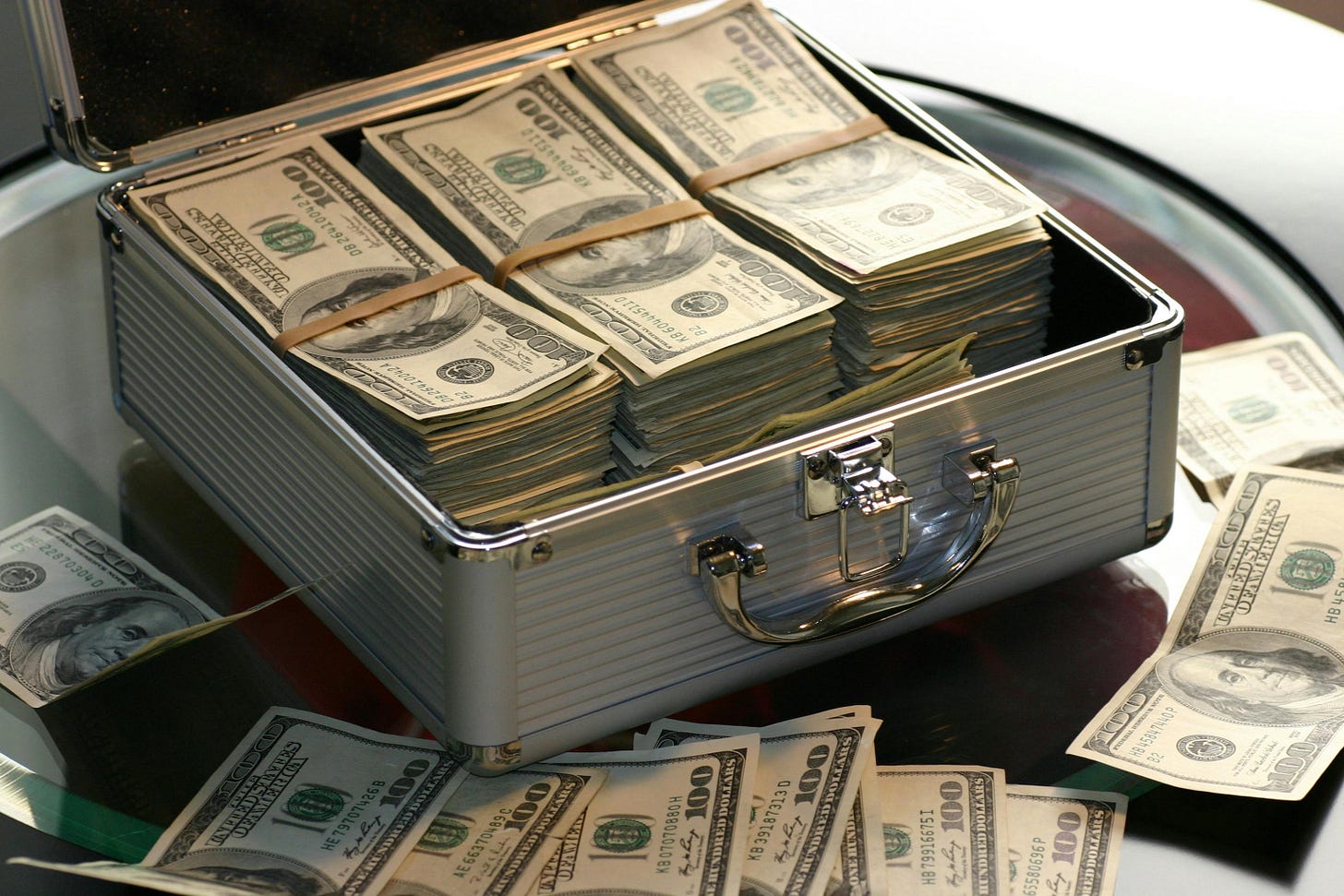Hi Everyone,
Happy New Year 2024!
First of all, wishing all of you greetings of this new year, and wish everyone great Health, lots of Wealth, and a whole lot of Success in this new year. Let’s all strive to make this the best one yet!
I know it’s already been a few weeks but I think as long as we are still in January, the novelty of the new year doesn’t wear off. If you make notes and put dates, then I’m pretty sure you default to 2023 and then correct it to 2024 - I know and I’m still adjusting.
I hope that everyone had a great holiday period and that you got to enjoy it with your loved ones. I’m sure your days were better off than mine, considering that my kids successfully managed to get me chicken pox during the Christmas period which meant all travel plans were canceled and I was on self-imposed quarantine inside the house. It’s one thing to get chicken pox as a kid, but getting it as an adult?! Jeez, wouldn’t wish it on anyone.
Thankfully I managed to recover by the end of the year, and went out for a drive on the 1st of Jan - A cold but beautiful sunny afternoon, around The Hague. I took it as a sign that I was back on my feet again, the sun was shining, and the best is yet to come this new year.
I spent quite a bit of time over the past few weeks thinking about various things and thought that for today’s post, I just list down my thinking process about those different topics.
Documenting and Journaling
Finances and Wealth Building
Health & Workouts
Reading
Personal Growth
Family Goals
Travel
None of the above are in any particular order, although there are interdependencies.
I will most likely not be able to go through all the below this week, so will break this down over the next couple of weeks a couple of topics at a time.
For this week, let’s look at the first 2 topics.
Documenting and Journaling
I like systems, and following a routine for certain things. Many of you who know me closely know that I love to write with a Fountain pen and put things down on paper. The act of doing this slows time and allows me to absorb what I’m documenting.
The last few years I have had a Writing Journal where I make entries about events of days and my thoughts. If you are interested, I use Travelers Notebooks. I love the customizations and personalization this offers. You should check out some videos on Youtube about this one.
To accompany this I have a Weekly Calendar where I mark important events of the days, To-Do’s from a personal front, Birthday’s of friends and family, and I also write a daily summary of the highlights of the day. I prepare well before the start of the year so that all the important events that I’m aware of, are marked in the calendar already.
In addition to this, I have a notebook insert where I note down topics that interest me that I find from books, videos, etc. This is where I capture knowledge that I want to refer to again and again and it is in a condensed format with the golden nuggets that I find around me. This insert fits into the Travelers notebook so if you want to have different notebooks for different things, you can do that with these inserts and have all of them together in one place. Watch a video on Customizing traveler’s notebooks and you will understand how this is done.
While I continue this for 2024, I have included one more A6 Hobonichi Techo Notebook to the mix. This is where I intend to track my Habits such as Workouts, cold showers, vitamins, probiotics, etc. I note down my Weight and Blood sugar levels daily and also keep track of the Books I’m reading or Audiobooks I’m listening to. I also write down which TV series or Movies I have watched during the day. There is a blank page for the start of the month and this is where I note all the books I have begun and completed, TV Series, and Movies I have watched during the month.
This is now my 4th year where I am using a journal for various things and I can tell you, it is powerful. This year I also encouraged my wife to start using a journal and gifted her a mini-weekly calendar. She says that ever since she started using this journal, whatever she notes down, it gets done. She feels that since she wrote it down, she needs to check it off.
Successful people take the time out to write down goals, ambitions, and what they hope to achieve over the year. They also break it down to a tangible level down to activities they need to do each day. Keeping track of my weight, allows me to know if I’m progressing or not. I can adjust my workouts and diet based on this one metric. Keeping track of my reading habits gives me an indication that I am continuously stimulating my mind and learning something new every day.
This is a simple, yet highly underrated skill. It requires discipline and dedication to make the time to reflect and note down your thoughts. I highly encourage you to try it out and keep at it for a few months. You can start of with a simple notebook and break it down into To-do’s, Habit trackers, and Daily Reflections. As you progress you can add other things like Skills to learn, Goal trackers, etc.
Finances and Wealth Building
This is one of my favorite topics and something I have been quite passionate about for a long time now. This is one where I have built a lot of experience and yet continue to learn and pick tips and tricks from various people.
No one thinks about this aggressively till they reach their mid-thirties or even mid-forties to late forties. The sooner you start working on this plan, the sooner you get to your financial goals.
For myself, I have a tracker that I use to document the balances on different accounts in various places. I track my Investments, Savings, and even pension totals on a quarterly and annual basis to measure progress.
It starts with the question - Do you know your Net Worth, the actual number? This would be any money or money equivalent that you hold (Liquid and Non-liquid). If the answer is no, you have identified your starting point towards progress.
I would like to be at the point where I have created enough of capital that I am financially independent and then compounding takes care of my future needs. But to get there I need to identify what is that number, and how much can I realistically put aside to get to that number.
Another important thing to think about is what vehicles can I deploy my funds to that will get me the highest return at a risk level that I am comfortable with. Investments in Index Funds, ETFs, allow for diversified risk. The average yearly return of the S&P 500 is 10.5% over the last 100 years and adjusted for inflation it’s about 7.4%. Over the last 15 years, it has been 13.8% (11.2% adjusted for inflation) which are still really good returns.
Now that you have identified how much you have in the bank, and a vehicle that can you help you accelerate your savings, what you need is to know how much money you can save every month. To do this you will need to work on building a monthly budget.
A budget is a simplified term for your monthly Profit & Loss statement. You know what is/are your income(s) - this is the Gross Profit or Inflows. The crucial part of this is going to be - How much of what I get, do I get to keep?
The Loss/ Expenses/ Outflows column is the area that will determine the answer to that question. First, we need to categorize the Expenses part of the budget. In Ramit Sethi’s book - I Will Teach You to Be Rich, he has categorized this into 4 categories :
Fixed & Lifestyle Expenses - Rent or Mortgage, Utilities such as Electricity, Water & Gas, Insurances such as Health Insurance, Life Insurance, Auto Insurance, Liability Insurance, Travel Insurance, Home Insurance, Bank Account Expenses, Association expenses, Groceries (Upper-end stores vs local farmers market), Garbage disposal tax, Property taxes, Credit card payments, Telecom/ Mobile phone expenses etc. Subscriptions such as Netflix, Disney+, HBO, etc., etc.
Investments - Pension contributions, House Equity or House Fund, Emergency Fund, Stock and Index Investing.
Savings - Emergency Fund (3-6 months of monthly pay), Local and International Vacations and Travel, Home improvements (if you are a home owner).
Guilt Free Spending - This is basically the money you have available for doing whatever you want with it. Restaurants, Gifts, Coffee, Clothing stores, Gym and Spa, Club memberships, Movies, splurging on luxury purchases, hobbies etc.
Ramit advises the following percentage break up of take-home pay towards the different categories
Fixed Costs : 50- 60% of take-home pay
Investments : 10%
Savings Goals : 5-10%
Guilt Free Spending : 20-35%
The way the plan is executed is that your take-home pay goes category by category in the order shown above. Meaning you cant first take money for Guilt-free spending and then allocate to Fixed costs or Investments. If you have $100 then the first $50 goes to Fixed, next $10 goes to Investments, the next 10$ goes to Savings, and the last $30 goes to Guilt-Free Spending.
If lets say your Fixed Cost is $65, next $ 10 goes to Investments, the next 10$ goes to savings, and you are left with $ 15 for Guilt-free spending.
I would personally try to get to 25-30% on the Investments + Savings goal and a good strategy is to try and improve by 1% every month. So if you are at 15% on Investments and Savings combined today, then try to get to 16% in the following month, 17% the month after, so on and so forth. If you follow a plan on paper and not try to do this mentally, you are more likely to be successful.
I am quite sure that most people “Wing it” every month and probably don’t even assess if they have made progress at the end of every year. This is going to get painful every passing year and therefore the sooner you start putting pen to paper and making a plan for your Finances starting with a Budget, the faster you progress. Your future self will thank you for the decision you make today with regards to your finances.
Now that you have made a budget and identified how much you would like to contribute, the next task is to automate the process of Investing and make it a monthly routine. You can set it up as a recurring investment through your bank account directly towards your investment or brokerage account, or mark it in the calendar to make those transfers based on the frequency you have set.
Once you get a routine going, try and increase your $ contribution. Compounding will take care of the rest. The earlier you start, the longer you allow for compounding to work.
That’s it for this week. Planning is the first crucial step. Executing the plan is the next most important step. I hope this article inspires you to think about this topic and make a plan that you can execute.
Please share your comments and feedback. If you want ideas or help with making this plan, then please do reach out. I have helped people over the years to make a plan and take their first steps.
PS:
This year, I intend to modify a couple of things in the approach to the newsletters every week. I have not landed yet on exactly what I would like to adjust, so over the coming posts I will be experimenting with a few things. If you see any changes that you either like or don’t like, I would greatly appreciate that feedback.
Wishing everyone a great week ahead!
Jithin



